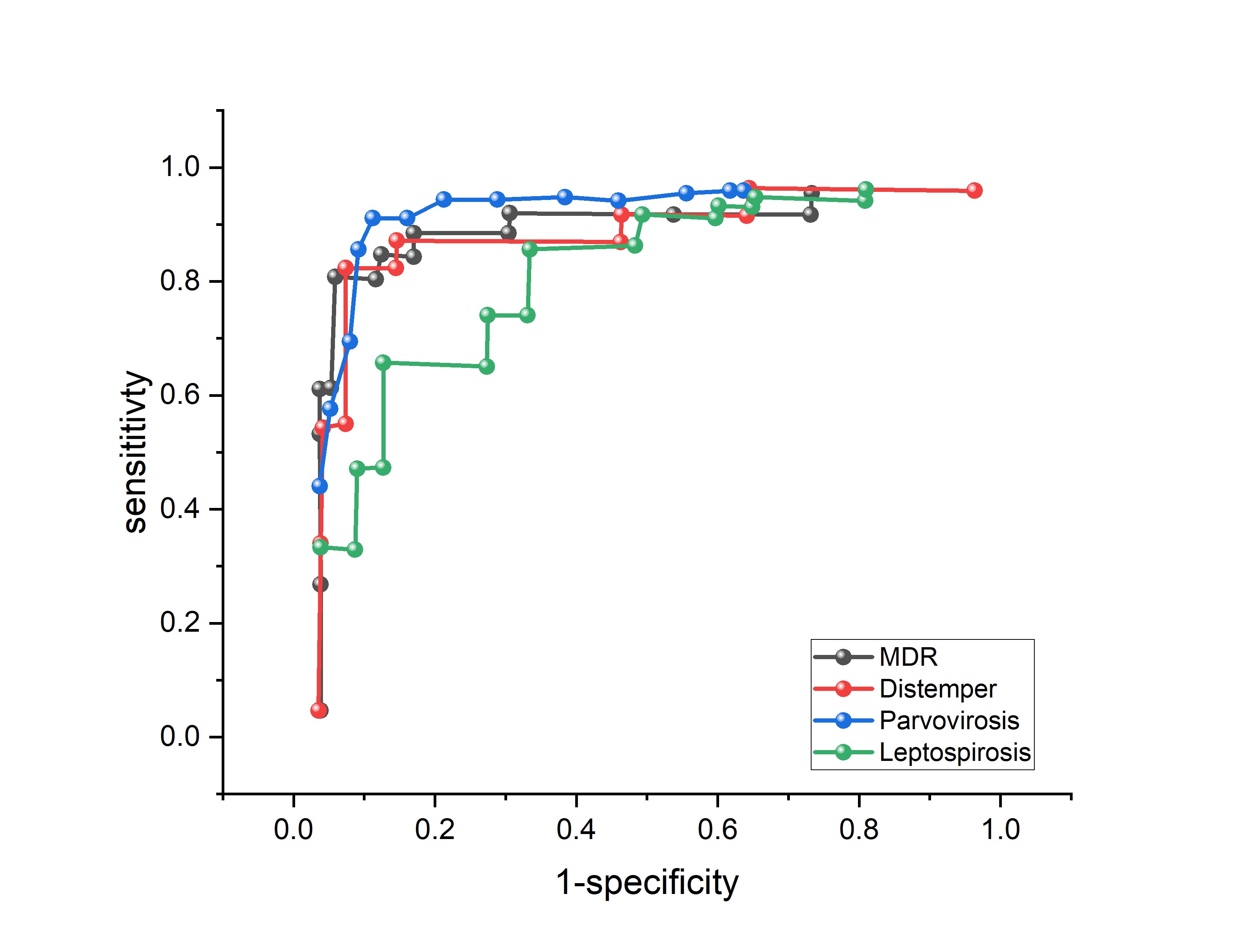Supporting Triage of Infected Dog Patients in a Veterinary disease control unit: Epidemiological Analysis and Recommendations
Abstract
The University of Lisbon's teaching hospital houses a Biology Isolate and Containment Unit for the hospitalisation of both confirmed and suspected cases of infectious illnesses in livestock. The goal of the research is to determine and explain the most common infectious illnesses observed over the course of seven years in the dog population in "BICU". With the purpose of classifying cases of infection, the importance of a number of epidemiological parameters was examined. A total of 700 dogs were hospitalised throughout the research time frame, and 400 (58.3%) of them had a confirmed case of an infectious condition, including parvovirosis (50.0%; 230 dogs), leptospirosis (22%; 88 dogs), a multidrug-resistant (MDR) bacterial infection (11%; 44 dogs), and dog distemper (9%; 36 dogs). Age under 2 years old (p = 0.001), inadequate parvovirosis vaccination (p = 0.001), age over 10 yrs old (p = 0.001), and overall existence of concurrent problems for MDR-infected individuals (p = 0.03) was also noted as possible hazard variables for such illnesses. To differentiate between cases as well as controls, logistical regression classifiers were built. For parvovirosis, MDR diseases, and distemper diseases, the estimations of both specificity and sensitivity are quite high (>0.83). The accuracy for detecting leptospirosis patients was poorer (0.77). In summary, as infectious illnesses are common, it is crucial to reduce their prevalence via efficient preventative measures.
References
Weese, J.S., Blondeau, J., Boothe, D., Guardabassi, L.G., Gumleyg, N., Papichh, M., Jesseni, L.R., Lappinj, M., Rankin, S., Westropp, J.L. and Sykes, J., 2021. International Society for Companion Animal Infectious Diseases (ISCAID) guidelines for the diagnosis and management of bacterial urinary tract infections in dogs and cats. JOURNAL OF JAPANESE ASSOCIATION OF VETERINARY NEPHROLOGY AND UROLOGY, 13(1), pp.46-63.
Oliva, J.L. and Johnston, K.L., 2021. Puppy love in the time of Corona: Dog ownership protects against loneliness for those living alone during the COVID-19 lockdown. International Journal of Social Psychiatry, 67(3), pp.232-242.
Machado, I.C., Nunes, T., Maximino, M., Malato, J., Tavares, L., Almeida, V., Sepúlveda, N. and Gil, S., 2023. Epidemiologic factors supporting triage of infected dog patients admitted to a veterinary hospital biological isolation and containment unit. Veterinary Sciences, 10(3), p.186.
Schaffer, P.A., Brault, S.A., Hershkowitz, C., Harris, L., Dowers, K., House, J., Aboellail, T.A., Morley, P.S. and Daniels, J.B., 2019. Pneumonic plague in a dog and widespread potential human exposure in a veterinary hospital, United States. Emerging Infectious Diseases, 25(4), p.800.
Fernández, M.D.P., Gaspe, M.S. and Gürtler, R.E., 2019. Inequalities in the social determinants of health and Chagas disease transmission risk in indigenous and creole households in the Argentine Chaco. Parasites & vectors, 12(1), pp.1-18.
Davies, R.H., Lawes, J.R. and Wales, A.D., 2019. Raw diets for dogs and cats: a review, with particular reference to microbiological hazards. Journal of Small Animal Practice, 60(6), pp.329-339.
Anvari, D., Narouei, E., Daryani, A., Sarvi, S., Moosazadeh, M., Hezarjaribi, H.Z., Narouei, M.R. and Gholami, S., 2020. The global status of Dirofilaria immitis in dogs: a systematic review and meta-analysis based on published articles. Research in veterinary science, 131, pp.104-116.
Klein, A.P., 2021. Pancreatic cancer epidemiology: understanding the role of lifestyle and inherited risk factors. Nature reviews Gastroenterology & hepatology, 18(7), pp.493-502.
Waltenburg, M.A., Basler, C., Nichols, M., Scheftel, J. and Stobierski, M.G., 2021. Veterinarians’ role in preventing zoonotic salmonellosis from hedgehogs. Journal of the American Veterinary Medical Association, 258(10), p.1066.
Eslahi, A.V., Hashemipour, S., Olfatifar, M., Houshmand, E., Hajialilo, E., Mahmoudi, R., Badri, M. and Ketzis, J.K., 2022. Global prevalence and epidemiology of Strongyloides stercoralis in dogs: a systematic review and meta-analysis. Parasites & Vectors, 15(1), pp.1-13.
Barcelos, A.M., Kargas, N., Maltby, J., Hall, S., Assheton, P. and Mills, D.S., 2021. Theoretical foundations to the impact of dog-related activities on human hedonic well-being, life satisfaction and eudaimonic well-being. International Journal of Environmental Research and Public Health, 18(23), p.12382.
Bedson, J., Skrip, L.A., Pedi, D., Abramowitz, S., Carter, S., Jalloh, M.F., Funk, S., Gobat, N., Giles-Vernick, T., Chowell, G. and de Almeida, J.R., 2021. A review and agenda for integrated disease models including social and behavioural factors. Nature human behaviour, 5(7), pp.834-846.
Shahin, K., Pearl, D.L., Martinko, C., Berke, O. and O’Sullivan, T.L., 2022. Examining the differential use of a North American animal poison control call center by veterinarians and the public for dog-related calls. PLoS one, 17(11), p.e0276959.
Pekin, A., Rynhoud, H., Brennan, B. and Magalhães, R.J.S., 2021. Dog bite Emergency department presentations in Brisbane metro south: Epidemiology and exploratory medical geography for targeted interventions. One Health, 12, p.100204.
Patterson, K.N., Beckmeyer, A., Bourgeois, T., Horvath, K.Z., Pratt, A.L., Armour, L., Wang, L., Minneci, P.C., Deans, K.J., Thakkar, R.K. and Parasidis, E., 2023. Legal epidemiology of paediatric dog bite injuries. Injury prevention, 29(2), pp.142-149.







